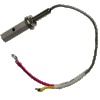Rob58
Pre-takeoff checklist
- Joined
- Feb 20, 2016
- Messages
- 360
- Display Name
Display name:
Rob
Getting ready to install an engine monitor and trying to get some facts about splicing the thermocouple wires for the EGT & CHT probes. I want to install a firewall connector giving me the ability to easily disconnect the harness when the engine needs to come off occasionally. So I would plan to use gold plated contacts in the connector – does this work without compromising the accuracy of the thermocouple output? What about the overall length of each circuit – do all leads needs to be the same length? Seems like there are some special considerations for thermocouple leads and I would like to learn more about this from some of you experts out there. Thanks!

